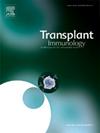在肾移植受者中,他克莫司与基于Belatacept的方案的新供者特异性抗体(dnDSA)的发展。
IF 1.4
4区 医学
Q4 IMMUNOLOGY
引用次数: 0
摘要
目的:Belatacept与较少的新发特异性抗体(dnDSA)发生相关,但很少有文献比较他克莫司和基于Belatacept的免疫抑制方案之间dnDSA发生的发生率。本研究的目的是调查两种维持方案在肾移植中dnDSA发展和临床结果的差异。方法:这是一项回顾性、单中心、队列研究,研究对象是2013年至2019年间接受贝拉他普或他克莫司免疫抑制方案的移植患者。主要终点是36 个月时dnDSA发生的发生率(MFI ≥ 1000)。次要结局包括肾功能、活检证实的排斥反应(BPAR)和患者/移植物存活。结果:90例患者符合纳入标准。主要结局发生在4例(8.9 %)belatacept患者和6例(13.3 %)他克莫司患者中,到达dnDSA的总中位时间为300 天(p = 0.51)。II类dnDSA发生在3例(6.7 %)belataccept患者和6例(13.3 %)他克莫司患者中。Belatacept患者发生BPAR的比率较低,但没有显著差异(4.4 % vs 13.3 %,p = 0.13),并且在36 个月时具有较好的肾功能(中位值66 ml/min vs 53 ml/min, p )。结论:重新使用Belatacept并没有导致dnDSA发展的统计学差异,但确实显示了较低的II级dnDSA和BPAR发展。总的来说,与以他克莫司为基础的方案相比,贝拉他普与肾功能改善有关。本文章由计算机程序翻译,如有差异,请以英文原文为准。
De novo donor specific antibody (dnDSA) development with tacrolimus versus Belatacept based regimens in kidney transplant recipients
Purpose
Belatacept has been associated with less de novo specific antibody (dnDSA) development, but few publications have compared the incidence of dnDSA development between tacrolimus and belatacept-based immunosuppression regimens. The purpose of this study was to investigate the differences in dnDSA development and clinical outcomes between these two maintenance regimens in kidney transplant.
Methods
This was a retrospective, single center, cohort study of patients transplanted between 2013 and 2019 who received a de novo belatacept or tacrolimus-based immunosuppression regimen. The primary outcome was the incidence of dnDSA development (MFI ≥ 1000) at 36 months. Secondary outcomes included renal function, biopsy proven rejection (BPAR), and patient/graft survival.
Results
Ninety patients met inclusion criteria. The primary outcome occurred in 4 (8.9 %) belatacept patients and 6 (13.3 %) tacrolimus patients, with an overall median time to dnDSA of 300 days (p = 0.51). Class II dnDSA development occurred in 3 (6.7 %) belatacept patients and 6 (13.3 %) tacrolimus patients. Belatacept patients had a lower, but not significantly different, rate of developing BPAR (4.4 % vs 13.3 %, p = 0.13) and had superior renal function at 36 months (median 66 ml/min vs 53 ml/min, p < 0.01). Overall, there was excellent patient/graft survival at 36 months post-transplant.
Conclusion
De novo belatacept use did not result in a statistically significant difference in the development of dnDSAs but did show a numerically lower class II dnDSA and BPAR development. Overall, belatacept was associated with improved renal function as compared to tacrolimus-based regimens.
求助全文
通过发布文献求助,成功后即可免费获取论文全文。
去求助
来源期刊

Transplant immunology
医学-免疫学
CiteScore
2.10
自引率
13.30%
发文量
198
审稿时长
48 days
期刊介绍:
Transplant Immunology will publish up-to-date information on all aspects of the broad field it encompasses. The journal will be directed at (basic) scientists, tissue typers, transplant physicians and surgeons, and research and data on all immunological aspects of organ-, tissue- and (haematopoietic) stem cell transplantation are of potential interest to the readers of Transplant Immunology. Original papers, Review articles and Hypotheses will be considered for publication and submitted manuscripts will be rapidly peer-reviewed and published. They will be judged on the basis of scientific merit, originality, timeliness and quality.
 求助内容:
求助内容: 应助结果提醒方式:
应助结果提醒方式:


